TP-Link TD-W8960N User Manual
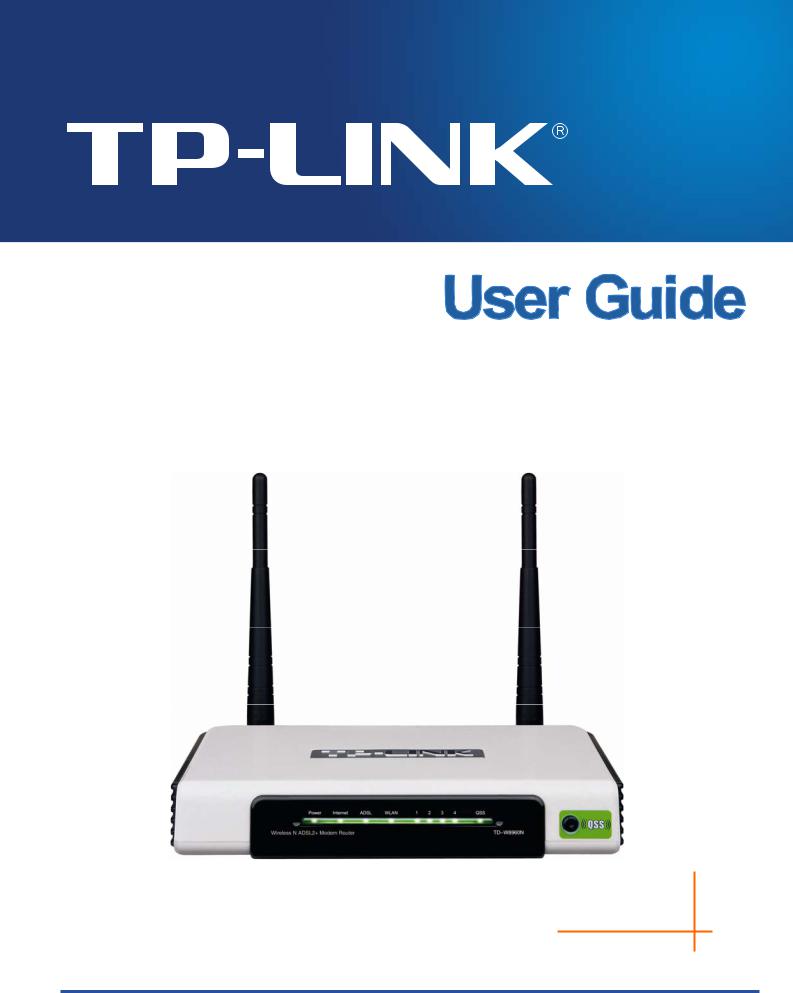
TD-W8960N
Wireless N ADSL2+ Modem Router
Rev: 1.0.0 1910010174
COPYRIGHT & TRADEMARKS
Specifications are subject to change without notice.  is a registered trademark of TP-LINK TECHNOLOGIES CO., LTD. Other brands and product names are trademarks or registered trademarks of their respective holders.
is a registered trademark of TP-LINK TECHNOLOGIES CO., LTD. Other brands and product names are trademarks or registered trademarks of their respective holders.
No part of the specifications may be reproduced in any form or by any means or used to make any derivative such as translation, transformation, or adaptation without permission from TP-LINK TECHNOLOGIES CO., LTD. Copyright © 2009 TP-LINK TECHNOLOGIES CO., LTD. All rights reserved.
http://www.tp-link.com

FCC STATEMENT
This equipment has been tested and found to comply with the limits for a Class B digital device, pursuant to part 15 of the FCC Rules. These limits are designed to provide reasonable protection against harmful interference in a residential installation. This equipment generates, uses and can radiate radio frequency energy and, if not installed and used in accordance with the instructions, may cause harmful interference to radio communications. However, there is no guarantee that interference will not occur in a particular installation. If this equipment does cause harmful interference to radio or television reception, which can be determined by turning the equipment off and on, the user is encouraged to try to correct the interference by one or more of the following measures:
•Reorient or relocate the receiving antenna.
•Increase the separation between the equipment and receiver.
•Connect the equipment into an outlet on a circuit different from that to which the receiver is connected.
•Consult the dealer or an experienced radio/ TV technician for help.
This device complies with part 15 of the FCC Rules. Operation is subject to the following two conditions:
1)This device may not cause harmful interference.
2)This device must accept any interference received, including interference that may cause undesired operation.
Any changes or modifications not expressly approved by the party responsible for compliance could void the user’s authority to operate the equipment.
FCC RF Radiation Exposure Statement
This equipment complies with FCC RF radiation exposure limits set forth for an uncontrolled environment. This device and its antenna must not be co-located or operating in conjunction with any other antenna or transmitter.
“To comply with FCC RF exposure compliance requirements, this grant is applicable to only Mobile Configurations. The antennas used for this transmitter must be installed to provide a separation distance of at least 20 cm from all persons and must not be co-located or operating in conjunction with any other antenna or transmitter.”

CE Mark Warning
This is a class B product. In a domestic environment, this product may cause radio interference, in which case the user may be required to take adequate measures.
National Restrictions
2400.0-2483.5 MHz
Country |
Restriction |
Reason/remark |
|
|
|
Bulgaria |
|
General authorization required for outdoor use and |
|
public service |
|
|
|
Outdoor use limited to 10 France mW e.i.r.p. within the band
2454-2483.5 MHz
Military Radiolocation use. Refarming of the 2.4 GHz band has been ongoing in recent years to allow current relaxed regulation. Full implementation planned 2012
Italy |
|
If used outside of own premises, general authorization is |
|
|
required |
||
|
|
||
|
|
|
|
Luxembourg |
None |
General authorization required for network and service |
|
supply(not for spectrum) |
|||
|
|
||
|
|
|
|
Norway |
Implemented |
This subsection does not apply for the geographical area |
|
within a radius of 20 km from the centre of Ny-Ålesund |
|||
|
|
||
|
|
|
|
Russian Federation |
|
Only for indoor applications |
|
|
|
|
Note: Please don’t use the product outdoors in France.

 TP-LINK TECHNOLOGIES CO., LTD
TP-LINK TECHNOLOGIES CO., LTD
DECLARATION OF CONFORMITY
For the following equipment:
Product Description: Wireless N ADSL2+ Modem Router
Model No.: TD-W8960N
Trademark: TP-LINK
We declare under our own responsibility that the above products satisfy all the technical regulations applicable to the product within the scope of Council Directives:
Directives 1999/5/EC
The above product is in conformity with the following standards or other normative documents:
ETSI EN 300 328 V1.7.1:2006
ETSI EN 301 489-1 V1.8.1:2008 & ETSI EN 301 489-17 V1.3.2:2008 EN60950-1:2006
EN62311:2008
Directives 2004/108/EC
The above product is in conformity with the following standards or other normative documents
EN 55022:2006+A1:2007
EN 55024:1998+A1:2001+A2:2003 EN 61000-3-2:2006
EN 61000-3-3:1995+A1:2001+A2:2005
Directives 2006/95/EC
The above product is in conformity with the following standards or other normative documents
EN60950-1:2006
Person is responsible for marking this declaration:
Zhao Jianjun
Director of International Business
TP-LINK TECHNOLOGIES CO., LTD.
South Building, No.5 Keyuan Road, Central Zone, Science & Technology Park, Nanshan,
Shenzhen, P. R. China
|
|
CONTENTS |
|
Package Contents .................................................................................................... |
1 |
||
Chapter 1. Product Overview................................................................................... |
2 |
||
1.1 |
Overview of the Router .................................................................................................... |
2 |
|
1.2 |
Main Features .................................................................................................................. |
3 |
|
1.3 |
Panel Layout .................................................................................................................... |
4 |
|
|
1.3.1 |
The Front Panel ................................................................................................................... |
4 |
|
1.3.2 |
The Back Panel .................................................................................................................... |
5 |
Chapter 2. Connecting the Router........................................................................... |
6 |
||
2.1 |
System Requirements...................................................................................................... |
6 |
|
2.2 |
Installation Environment Requirements ........................................................................... |
6 |
|
2.3 |
Connecting the Router ..................................................................................................... |
6 |
|
Chapter 3. Quick Installation Guide ........................................................................ |
8 |
||
3.1 |
TCP/IP Configuration ....................................................................................................... |
8 |
|
3.2 |
Quick Installation Guide ................................................................................................. |
10 |
|
Chapter 4. Configuring the Router ........................................................................ |
14 |
||
4.1 |
Login |
.............................................................................................................................. |
14 |
4.2 |
Device .....................................................................................................................Info |
14 |
|
4.3 |
Quick ....................................................................................................................Setup |
15 |
|
4.4 |
Advanced .............................................................................................................Setup |
15 |
|
|
4.4.1 ................................................................................................................. |
Layer2 Interface |
16 |
|
4.4.2 ...................................................................................................................... |
WAN Service |
19 |
|
4.4.3 .................................................................................................................................... |
LAN |
28 |
|
4.4.4 .......................................................................................................... |
MAC Address Clone |
30 |
|
4.4.5 .................................................................................................................................... |
NAT |
31 |
|
4.4.6 .............................................................................................................................. |
Security |
36 |
|
4.4.7 ................................................................................................................. |
Parental Control |
41 |
|
4.4.8 ............................................................................................................... |
Quality of Service |
44 |
|
4.4.9 ............................................................................................................................... |
Routing |
46 |
|
4.4.10 .................................................................................................................................... |
DNS |
49 |
|
4.4.11 .................................................................................................................................... |
DSL |
52 |
|
4.4.12 ................................................................................................................................. |
UPNP |
52 |
|
4.4.13 |
Dns Proxy........................................................................................................................... |
53 |
|
4.4.14 |
Interface Grouping ............................................................................................................. |
53 |
|
4.4.15 |
LAN Ports........................................................................................................................... |
56 |
|
4.4.16 IPSec.................................................................................................................................. |
57 |
|
4.5 |
Wireless ......................................................................................................................... |
59 |
|
|
4.5.1 |
Basic .................................................................................................................................. |
59 |
|
4.5.2 |
Security .............................................................................................................................. |
60 |
|
4.5.3 |
MAC Filter .......................................................................................................................... |
71 |
|
4.5.4 |
Wireless Bridge.................................................................................................................. |
72 |
|
4.5.5 |
Advanced ........................................................................................................................... |
74 |
|
4.5.6 |
Station info ......................................................................................................................... |
76 |
4.6 |
Diagnostics..................................................................................................................... |
76 |
|
4.7 Management .................................................................................................................. |
77 |
||
|
4.7.1 |
Settings .............................................................................................................................. |
77 |
|
4.7.2 |
System Log ........................................................................................................................ |
80 |
|
4.7.3 |
SNMP Agent ...................................................................................................................... |
81 |
|
4.7.4 |
TR-069 client...................................................................................................................... |
82 |
|
4.7.5 |
Internet Time...................................................................................................................... |
84 |
|
4.7.6 |
Access ControlPasswords ............................................................................................... |
84 |
|
4.7.7 |
Update Software ................................................................................................................ |
85 |
|
4.7.8 |
Reboot................................................................................................................................ |
86 |
Appendix A: FAQ.................................................................................................... |
87 |
||
Appendix B: Configuring the PC........................................................................... |
90 |
||
Appendix C: Specifications ................................................................................... |
94 |
||
Appendix D: Glossary ............................................................................................ |
95 |
||

TD-W8960N  Wireless N ADSL2+ Modem Router User Guide
Wireless N ADSL2+ Modem Router User Guide
Package Contents
The following contents should be found in your package:
¾One TD-W8960N Wireless N ADSL2+ Modem Router
¾One DC power Adapter for TD-W8960N Wireless N ADSL2+ Modem Router
¾Quick Installation Guide
¾One RJ45 cable
¾Two RJ11 cables
¾One ADSL splitter
¾One Resource CD for TD-W8960N Wireless N ADSL2+ Modem Router, including:
•This User Guide
•Other Helpful Information
) Note:
Make sure that the package contains the above items. If any of the listed items are damaged or missing, please contact with your distributor.
1

TD-W8960N  Wireless N ADSL2+ Modem Router User Guide
Wireless N ADSL2+ Modem Router User Guide
Chapter 1. Product Overview
Thank you for choosing the TD-W8960N Wireless N ADSL2+ Modem Router.
1.1 Overview of the Router
The TD-W8960N Wireless N ADSL2+ Modem Router integrates 4-port Switch, Firewall, NAT-Router and Wireless AP. Powered by 2x2 MIMO technology, the Wireless N Router delivers exceptional range and speed, which can fully meet the need of Small Office/Home Office (SOHO) networks and the users demanding higher networking performance.
The TD-W8960N Wireless N ADSL2+ Modem Router utilizes integrated ADSL2+ transceiver and high speed MIPS CPU. The Router supports full-rate ADSL2+ connectivity conforming to the ITU and ANSI specifications.
In addition to the basic DMT physical layer functions, the ADSL2+ PHY supports dual latency ADSL2+ framing (fast and interleaved) and the I.432 ATM Physical Layer.
Incredible Speed
The router provides up to 300Mbps wireless connection with other 802.11n wireless clients. The incredible speed makes it ideal for handling multiple data streams at the same time, which ensures your network stable and smooth. The performance of this 802.11n wireless Router will give you the unexpected networking experience at speed 650% faster than 802.11g. It is also compatible with all IEEE 802.11g and IEEE 802.11b products.
Multiple Security Protections
With multiple protection measures, including SSID broadcast control and wireless LAN 64/128 WEP encryption, Wi-Fi protected Access (WPA2-PSK, WPA-PSK), as well as advanced Firewall protections, the TD-W8960N Wireless N ADSL2+ Modem Router provides complete data privacy.
Flexible Access Control
The Router provides flexible access control, so that parents or network administrators can establish restricted access policies for children or staff. It also supports Virtual Server and DMZ host for Port Triggering, and then the network administrators can manage and monitor the network in real time with the remote management function.
Simple Installation
Since the Router is compatible with virtually all the major operating systems, it is very easy to manage. Quick Setup Wizard is supported and detailed instructions are provided step by step in this user guide. Before installing the Router, please look through this guide to know all the Router’s functions.
2

TD-W8960N  Wireless N ADSL2+ Modem Router User Guide
Wireless N ADSL2+ Modem Router User Guide
1.2 Main Features
¾Complies with IEEE 802.11n draft version 2.0 to provide a wireless data rate of up to 300Mbps.
¾One RJ11 LINE port, four 10/100M Auto-Negotiation RJ45 LAN ports, supporting Auto MDI/MDIX.
¾Quick response semi-conductive surge protect circuit, reliable surge-protect function.
¾AFE to support Annex A/C/I/J/K/M, and L deployments.
¾Provides external splitter.
¾Multi-user sharing a high-speed Internet connection
¾Connecting the internet on demand and disconnecting from the Internet when idle for PPPoE.
¾Provides WPA/WPA2, WPA-PSK/WPA2-PSK data security, TKIP/AES encryption security.
¾Provides 64/128-bit WEP encryption security and wireless LAN ACL (Access Control List).
¾Adopts Advanced DMT modulation and demodulation technology.
¾Adopts 300M wireless LAN transmission technology.
¾Supports access control, parents and network administrators can establish restricted access policies based on time of day for children or staff.
¾Supports Virtual Server, Port Triggering and DMZ host.
¾Supports UPnP, Dynamic DNS, Static Routing.
¾Supports bridge mode and Router function.
¾Supports Web management.
¾Supports firmware upgrade.
¾Supports Flow Statistics.
¾Supports QSS (Quick Secure Setup).
¾Built-in firewall supporting IP address filtering, MAC address filtering and parental control.
¾Built-in DHCP server.
3
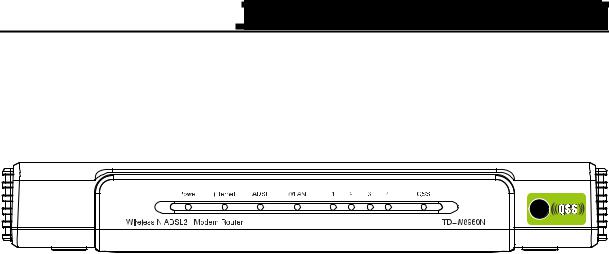
TD-W8960N  Wireless N ADSL2+ Modem Router User Guide
Wireless N ADSL2+ Modem Router User Guide
1.3 Panel Layout
1.3.1 The Front Panel
The Router’s LEDs are located on the front panel.
Figure 1-1
The Router’s LEDs and the QSS button are located on the front panel (View from left to right).
|
Name |
|
Status |
|
Description |
|
|
|
|
|
|
|
|
|
Power |
|
On |
|
Power is on |
|
|
|
|
|
|
|
|
|
|
Off |
Power is off |
|
||
|
|
|
|
|||
|
|
|
On |
|
A successful PPP connection has been built |
|
|
|
|
|
|
|
|
|
Internet |
|
Flashing |
Data is being transferred over the Internet |
|
|
|
|
|
Off |
|
There is no successful PPP connection or the |
Router |
|
|
|
|
works on Bridge mode |
|
|
|
|
|
|
|
|
|
|
|
|
On |
|
The LINE port has connected to ISP’s network |
|
|
ADSL |
|
|
|
|
|
|
|
Flashing |
|
The LINE port is connecting to the ISP’s network |
|
|
|
|
|
|
|
|
|
|
|
|
Off |
The LINE port is disconnected |
|
|
|
|
|
On |
|
The Wireless function is enabled |
|
|
WLAN |
|
Flashing |
Sending or receiving data over wireless network |
|
|
|
|
|
|
|
|
|
|
|
|
Off |
The Wireless function is disabled |
|
|
|
|
|
|
|
|
|
|
|
|
On |
|
There is a device linked to the corresponding port but there |
|
|
|
|
|
is no activity |
|
|
|
LAN 1-4 |
|
|
|
|
|
|
|
Flashing |
There is an active device linked to the corresponding port |
|||
|
|
|
|
|
|
|
|
|
|
Off |
There is no device linked to the corresponding port |
|
|
|
|
|
On |
|
A wireless device has been successfully added |
to the |
|
|
|
|
network by QSS function |
|
|
|
|
|
|
|
|
|
|
QSS |
|
Flashing |
|
A wireless device is connecting to the network by QSS |
|
|
|
|
function |
|
||
|
|
|
|
|
|
|
|
|
|
Off |
|
The wireless device failed to be added to the network by |
|
|
|
|
|
QSS function. Or have no QS connection |
|
|
|
|
|
|
|
|
|
|
|
|
|
|
|
|
) Note:
After a device is successfully added to the network by QSS function, the QSS LED will keep on for about 2 minutes and then turn off.
4
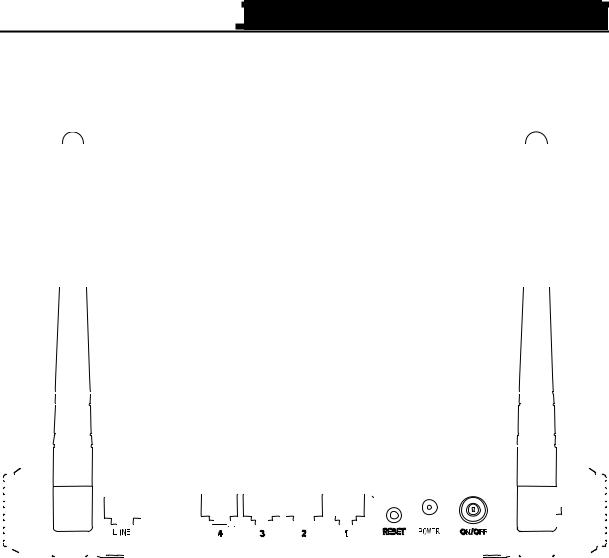
TD-W8960N  Wireless N ADSL2+ Modem Router User Guide
Wireless N ADSL2+ Modem Router User Guide
1.3.2 The Back Panel
The Router's ports, where the cables are connected, and RESET button are located on the back panel.
Figure 1-2
¾LINE: Connect to the Modem Port of Splitter or to the telephone line.
¾1, 2, 3, 4 (LAN): The ports (1, 2, 3, 4) connect the Router to the local PC(s).
¾Reset Button: There are two ways to reset the Router's factory defaults.
1)Use the Restore Default function on Management -> settings page in the router's Web-based Utility.
2)Use the Factory Default Reset button: With the Router powered on, use a pin to press and hold the Reset button (more than 5 seconds) until the Internet LED becomes quick-flash from slow-flash. And then release the button and wait the Router to reboot to its factory default settings.
¾POWER: The Power plug is where you will connect the power adapter.
¾ON/OFF: The switch for the power.
¾Wireless antennas: To receive and transmit the wireless data.
5

TD-W8960N  Wireless N ADSL2+ Modem Router User Guide
Wireless N ADSL2+ Modem Router User Guide
Chapter 2. Connecting the Router
2.1 System Requirements
¾ Broadband Internet Access Service (DSL/Cable/Ethernet).
¾ PCs with a working Ethernet Adapter and an Ethernet cable with RJ45 connectors.
¾ TCP/IP protocol on each PC.
¾ Web browser, such as Microsoft Internet Explorer, Mozilla Firefox or Apple Safari.
2.2 Installation Environment Requirements
¾ Place the Router in a well ventilated place far from any heater or heating vent.
¾ Avoid direct irradiation of any strong light (such as sunlight)
¾ Keep at least 2 inches (5 cm) of clear space around the Router
¾ Operating temperature: 0 ~40 (32 ~104 ).
¾ Operating Humidity: 10% ~ 90% RH Non-congealing.
2.3 Connecting the Router
Before installing the Router, please make sure your broadband service provided by your ISP is available. If there is any problem, please contact your ISP. After that, please install the Router according to the following steps. Don't forget to pull out the power plug and keep your hands dry.
1.Locate an optimum location for the Router. The best place is usually at the center of your wireless network.
2.Adjust the direction of the antenna. Normally, upright is a good direction.
3.Connect your PC and Switch/Hub in your LAN to the LAN Ports of the Router. (If you have a wireless NIC and want to have wireless connection, please skip this step.)
4.Connect the telephone line to the Line port on the Router.
Or you can access the Internet and make calls at the same time by using a separate splitter to divide the data and voice. The external splitter has three ports:
•LINE: Connect to the wall jack
•PHONE: Connect to the phone sets
•MODEM: Connect to the ADSL LINE port of Device
Plug one end of the twisted-pair ADSL cable into the ADSL LINE port on the rear panel of Device. Connect the other end to the MODEM port of the external splitter.
5.Connect the power adapter to the power plug of the Router, and the other end into an electrical outlet.
6
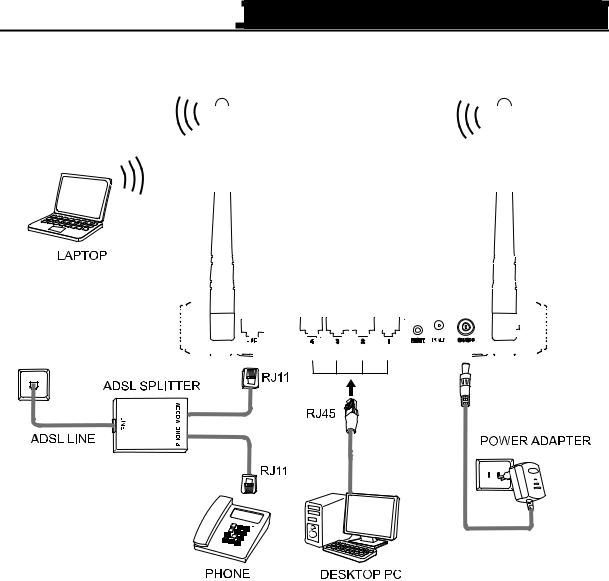
TD-W8960N  Wireless N ADSL2+ Modem Router User Guide
Wireless N ADSL2+ Modem Router User Guide
6.Turn on the ON/OFF switch to power the Device. It will start to work automatically.
Figure 2-1
7

TD-W8960N  Wireless N ADSL2+ Modem Router User Guide
Wireless N ADSL2+ Modem Router User Guide
Chapter 3. Quick Installation Guide
This chapter will show you how to configure the basic functions of your TD-W8960N Wireless N ADSL2+ Modem Router using Quick Setup Wizard within minutes.
3.1 TCP/IP Configuration
The default IP address of the Router is 192.168.1.1. And the default Subnet Mask is 255.255.255.0. These values can be changed as you desire. In this guide, we use all the default values for description.
Connect the local PC to the LAN ports of the Router. And then you can configure the IP address for your PC in the following two ways.
1.Configure the IP address manually
1)Set up the TCP/IP Protocol for your PC. If you need instructions as to how to do this, please refer to Appendix B: "Configuring the PC".
2)Configure the network parameters. The IP address is 192.168.1.xxx ("xxx" is any number from 2 to 254), Subnet Mask is 255.255.255.0, and Gateway is 192.168.1.1 (The Router's default IP address)
2.Obtain an IP address automatically
1)Set up the TCP/IP Protocol in "Obtain an IP address automatically" mode on your PC. If you need instructions as to how to do this, please refer to Appendix B: "Configuring the PC”.
2)Then the built-in DHCP server will assign IP address for the PC.
Now, you can run the Ping command in the command prompt to verify the network connection between your PC and the Router. The following example is in Windows XP OS.
Open a command prompt, and type ping 192.168.1.1, and then press Enter.
3.If the result displayed is similar to the Figure 3-1, it means the connection between your PC and the Router has been established well.
8
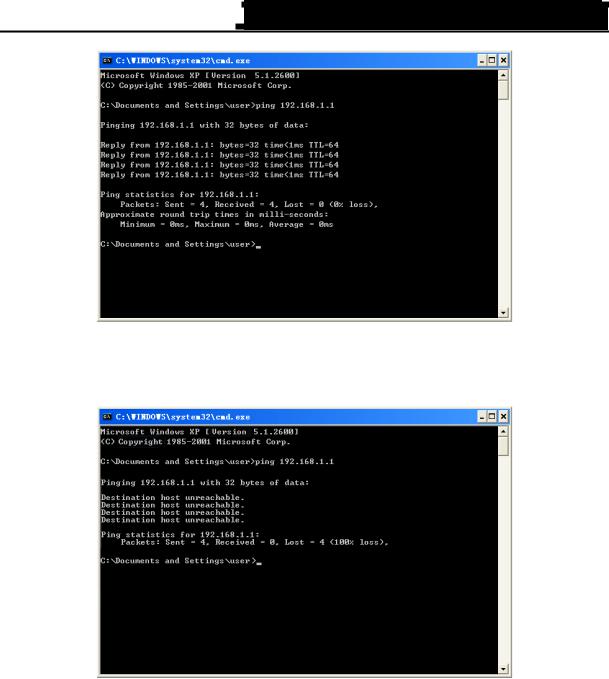
TD-W8960N  Wireless N ADSL2+ Modem Router User Guide
Wireless N ADSL2+ Modem Router User Guide
Figure 3-1 Success result of Ping command
¾If the result displayed is similar to the Figure 3-2, it means the connection between your PC and the Router is failed.
Figure 3-2 Failure result of Ping command
Please check the connection following these steps:
1.Is the connection between your PC and the Router correct?
) Note:
The 1/2/3/4 LEDs of LAN ports which you link to on the Router and LEDs on your PC's adapter should be lit.
2.Is the TCP/IP configuration for your PC correct?
) Note:
If the Router's IP address is 192.168.1.1, your PC's IP address must be within the range of 192.168.1.2 ~ 192.168.1.254.
9

TD-W8960N  Wireless N ADSL2+ Modem Router User Guide
Wireless N ADSL2+ Modem Router User Guide
3.2 Quick Installation Guide
With a Web-based utility, it is easy to configure and manage the TD-W8960N Wireless N ADSL2+ Modem Router. The Web-based utility can be used on any Windows, Macintosh or UNIX OS with a Web browser, such as Microsoft Internet Explorer, Mozilla Firefox or Apple Safari.
1.To access the configuration utility, open a web-browser and type in the default address 192.168.1.1 in the address field of the browser.
Figure 3-3
After a moment, a login window will appear, similar to the Figure 3-4. Enter admin for the User Name and Password, both in lower case letters. Then click the OK button or press the
Enter key.
Figure 3-4
) Note:
Do not mix up the user name and password with your ADSL account user name and password which needed for PPP connections.
) Note:
If the above screen does not pop-up, it means that your Web-browser has been set to a proxy. Go to Tools menu→Internet Options→Connections→LAN Settings, in the screen that appears, cancel the Using Proxy checkbox, and click OK to finish it.
2.After your successful login, you will see the Login screen as shown below. Click Quick Setup menu to access Quick Setup Wizard.
10
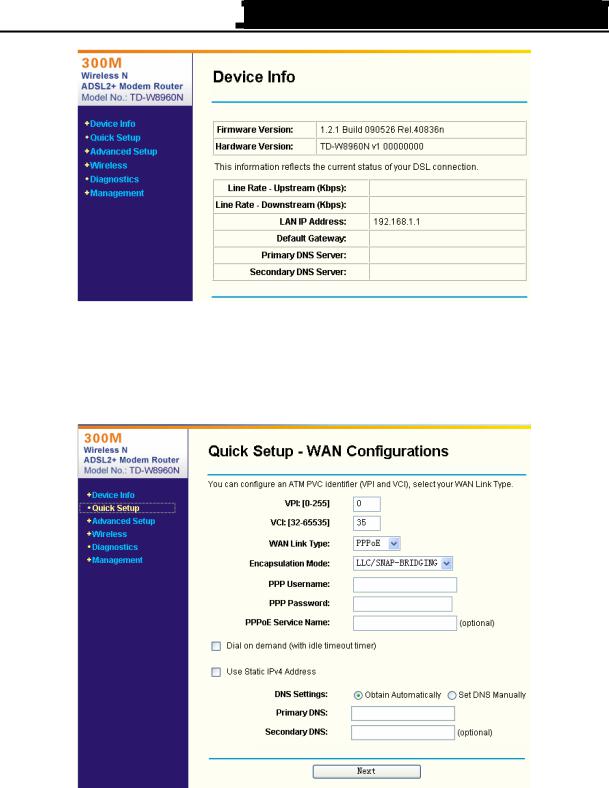
TD-W8960N  Wireless N ADSL2+ Modem Router User Guide
Wireless N ADSL2+ Modem Router User Guide
Figure 3-5
3.Change the VPI or VCI values which are used to define a unique path for your connection. If you have been given specific settings for this to configuration, type in the correct values assigned by your ISP. We select PPPoE WAN Link Type (For example), enter the Username and Password given by your ISP, and then click “Next”.
Figure 3-6
) Note:
The Quick Setup Wizard will guide you to configure the WAN Service over ATM interface.
4.On the Wireless Configurations screen, we use the default SSID, select Network Authentication (take WPA-PSK/WPA2-PSK for example), set a Pre-Shared Key, and then click “Save” to continue.
11
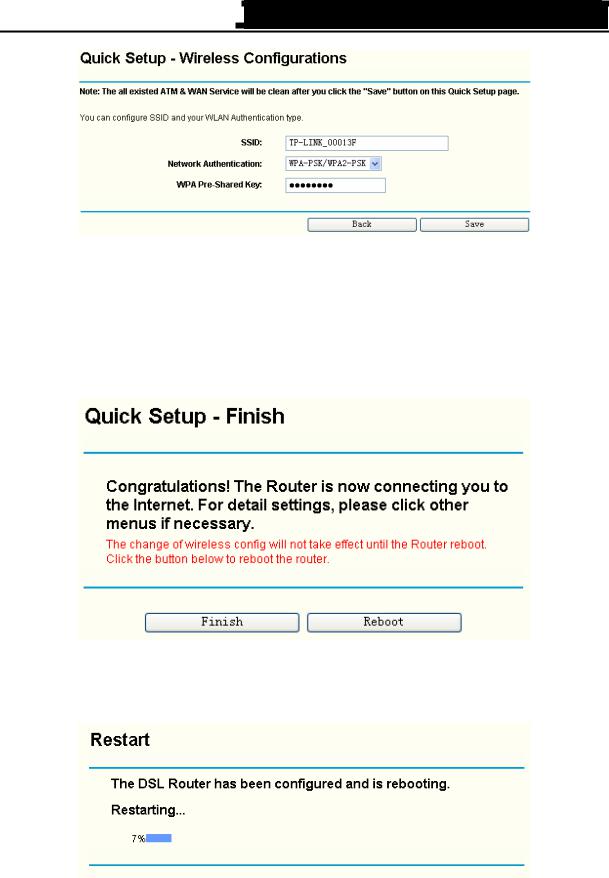
TD-W8960N  Wireless N ADSL2+ Modem Router User Guide
Wireless N ADSL2+ Modem Router User Guide
Figure 3-7
) Note:
All the existed ATM&WAN service will be clean after click the "Save" button on this Quick Setup page.
5.You will see the Finish screen below, click "Reboot" to save these settings.
Figure 3-8
6.Now, your ADSL Modem Router has been configured and is rebooting. Please do not power off the Router while it’s rebooting.
7.You will see the current configuration has been added to ATM Interface list (4.4.2 WAN Service) and Layer2 Interface list (4.4.1 Layer2 Interface).
12
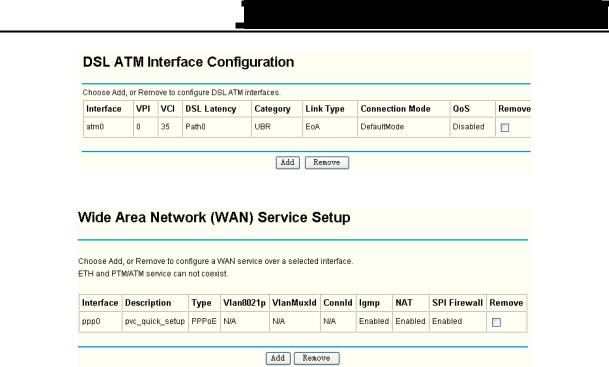
TD-W8960N  Wireless N ADSL2+ Modem Router User Guide
Wireless N ADSL2+ Modem Router User Guide
Figure 3-9
Figure 3-10
) Note:
More detailed configurations please refer to 4.4.1 Layer2 Interface and 4.4.2 WAN Service.
13
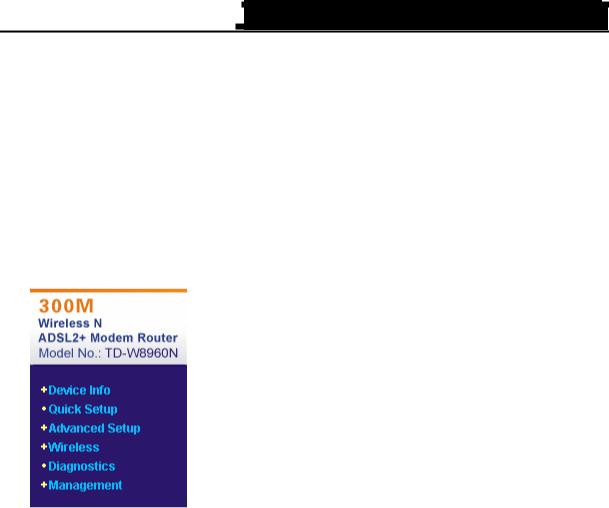
TD-W8960N  Wireless N ADSL2+ Modem Router User Guide
Wireless N ADSL2+ Modem Router User Guide
Chapter 4. Configuring the Router
This chapter will show each Web page's key functions and the configuration way.
4.1 Login
After your successful login, you will see the fifteen main menus on the left of the Web-based utility. On the right, there are the corresponding explanations and instructions.
The detailed explanations for each Web page’s key function are listed below.
4.2 Device Info
Choose “Device Info” menu, there are six submenus under the main menu: Summary, WAN, Statistics, Route, ARP and DHCP. This Device Info section mainly introduces the elementary information about the Router and its current settings in use. Click any of them, and you will be able to view the corresponding information.
Choose “Device Info”Æ“Summary”, you will see the Summary screen (shown in Figure 4-1)
The first table indicates the information about the version including Software and Hardware, the second table displays the current status of the TD-W8960N connection, this information will vary depending on the settings of the Router configured on the Advanced Setup screen.
14

TD-W8960N  Wireless N ADSL2+ Modem Router User Guide
Wireless N ADSL2+ Modem Router User Guide
Figure 4-2
) Note:
Click the other submenus under the main menu Device Info, and you will be able to view the corresponding information about WAN, Statistics, Route, ARP and DHCP.
4.3 Quick Setup
Please refer to Section 3.2 Quick Installation Guide.
4.4 Advanced Setup
Choose “Advanced Setup”, there are many submenus under the main menu. Among the submenus, Layer2 Interface, WAN Service, LAN etc. are default menus, while NAT, IP/MAC filtering of the Security, Quality of Service and DNS will appear only when you select some corresponding functions, click any one of them, and you will be able to configure the corresponding function.
15
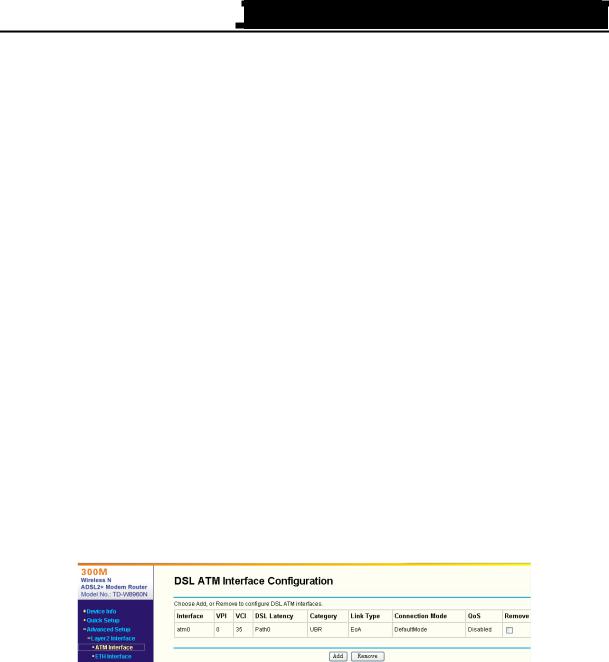
TD-W8960N  Wireless N ADSL2+ Modem Router User Guide
Wireless N ADSL2+ Modem Router User Guide
This Advanced Setup section mainly introduces how to configure the Router for adequate use. The detailed explanations for each subsection are provided below.
) Note:
To completely configure the WAN Interface, you need to first select the Layer2 Interface (4.4.1 Layer2 Interface) according to the connection ISP provides you, and then to select the type of the connection (4.4.2 WAN Service) for the further configuration.
4.4.1 Layer2 Interface
Choose “Advanced Setup”Æ“Layer2 Interface”, and you can select WAN Service Interface (layer2 interface) over ATM interfaces or ETH interface.
¾ATM Interface: Configure the Router to access Internet as an ADSL user. ISP provides you VPI (Virtual Path Identifier), VCI (Virtual Channel Identifier) settings and the DSL Interface with RJ11 connector. (Figure 2-1)
¾ETH Interface: Configure the Router to access Internet as an Ethernet user. ISP provides you Broadband Internet Service and the Ethernet Interface with RJ45 connector.
) Note:
If the interface is used by the configuration of the 4.4.2 WAN Service, you need to remove the corresponding WAN Service entry before you can remove it.
4.4.1.1 ATM interfaces
Choose “Advanced Setup”Æ“Layer2 InterfaceÆATM interface”, you can Configure ATM interfaces on the screen below.
Figure 4-3
¾Remove: Select the check box in the table on the screen above and then click the Remove tab, the corresponding interface will be deleted in the table.
¾Add: Click the button, and you can add a new interface in the next screen.
16

TD-W8960N  Wireless N ADSL2+ Modem Router User Guide
Wireless N ADSL2+ Modem Router User Guide
Figure 4-4
¾VPI/VCI: the VPI and VCI values provided by your ISP. Do not change them unless it was required by your ISP.
¾DSL Link Type: Select a DSL Link Type which is provided by your ISP. The options include EoA (it is for PPPoE, IPoE, and Bridge), PPPoA (PPP over ATM) and IPoA (IP over ATM).
¾Encapsulation Mode: The mode of the data processing over the Link Type you have selected. Uses the default setting, if you are not sure.
¾Service Category: Select the type of the service assigned by your ISP in the drop-down list. The default type is UBR Without PCR.
¾Connection Mode: Select the connection mode for EoA option of DSL Link Type. The options include Default mode for single service over one connection, VLAN MUX Mode for multiple Vlan service over one connection, and MSC Mode for Multiple Service over one connection.
¾Enable Quality of Service: If you want to adopt QoS (Quality of Service) for the connection, please select check box.
17
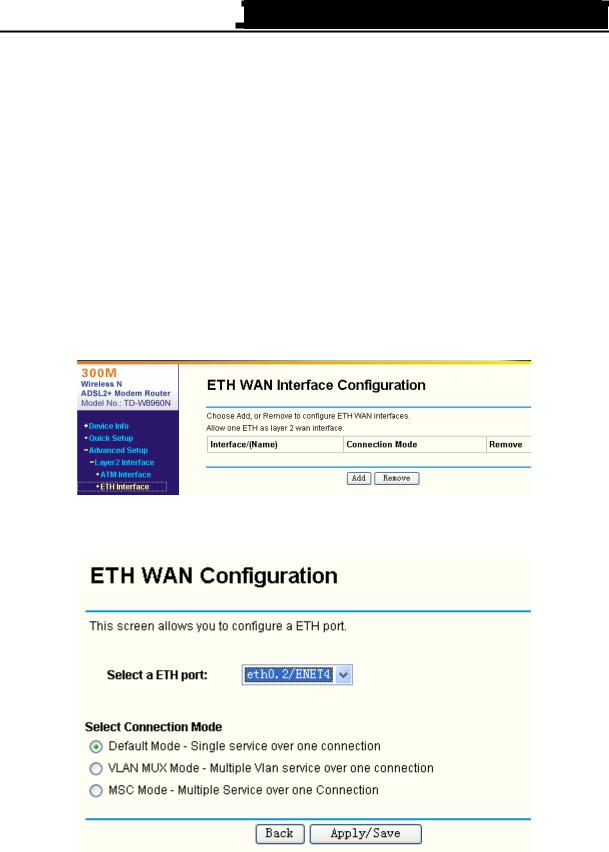
TD-W8960N  Wireless N ADSL2+ Modem Router User Guide
Wireless N ADSL2+ Modem Router User Guide
) Note:
Enabling packet level QoS for PVC improves performance for selected classes of applications. While QoS consumes system resources; therefore the number of PVC(s) will be reduced. Besides this, it cannot be set for the connection type of CBR and Real-time VBR. If you select the QoS service, the Quality of Service menu will be added to the Web-based Utility, the detailed configuration will be described in 4.4.8 Quality of Service.
4.4.1.2 ETH interfaces
Choose “Advanced Setup”Æ“Layer2 InterfaceÆETH Interface”, you can Configure ETH WAN interfaces on the screen below.
) Note:
Make sure the ETH port available, you should choose “Advanced Setup”Æ“LAN Ports” to enable the Virtual LAN Ports feature first.
Figure 4-5
¾Add: Click the Add button, and you can add a new interface in the next screen.
Figure 4-6
¾ETH port: Select an ETH port to configure as the WAN port.
18
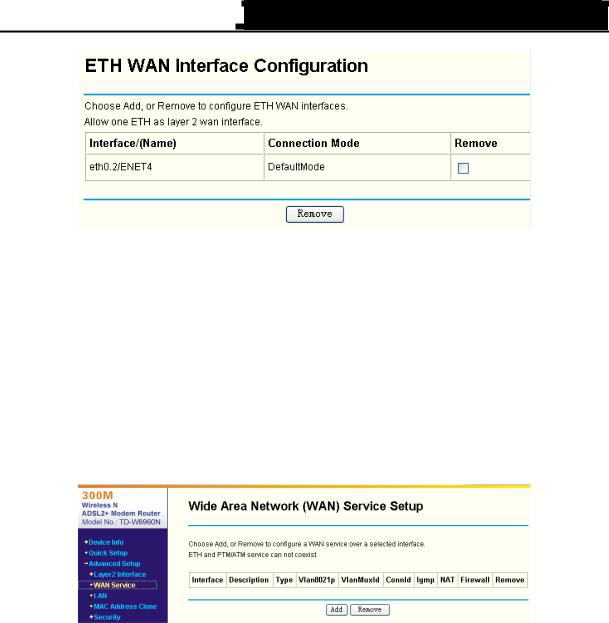
TD-W8960N  Wireless N ADSL2+ Modem Router User Guide
Wireless N ADSL2+ Modem Router User Guide
Figure 4-7
¾Remove: Select the check box in the table on the screen above and then click the Remove tab, the corresponding interface will be deleted in the table.
) Note:
One ETH is allowed to configure as the layer 2 WAN Interface.
4.4.2 WAN Service
Choose “Advanced Setup”Æ“WAN Service”, and you will see the WAN Port Information Table in the screen as shown below, which describes the WAN port settings and the relevant manipulation to each interface.
Figure 4-8
After you select the Lay2 Interface, please follow the instructions below to complete the further configuration of WAN Interface. There are five different configurations for the connection types, which are PPPoE, IPoE, Bridge, PPPoA, and IPoA. You can select the corresponding types according to your needs.
) Note:
The following section adopts different VPI, VCI to introduce further configuration for the different connection types, if you need to change the configuration of ATM PVC (VPI/VCI), you should go to the previous section (4.4.1 Layer2 Interface) to configure them again.
) Note:
ETH and ATM service can not coexist. If the ETH Interface had configured, you cannot configure any other WAN service over the ATM Interface until the ETH Interface is deleted.
19
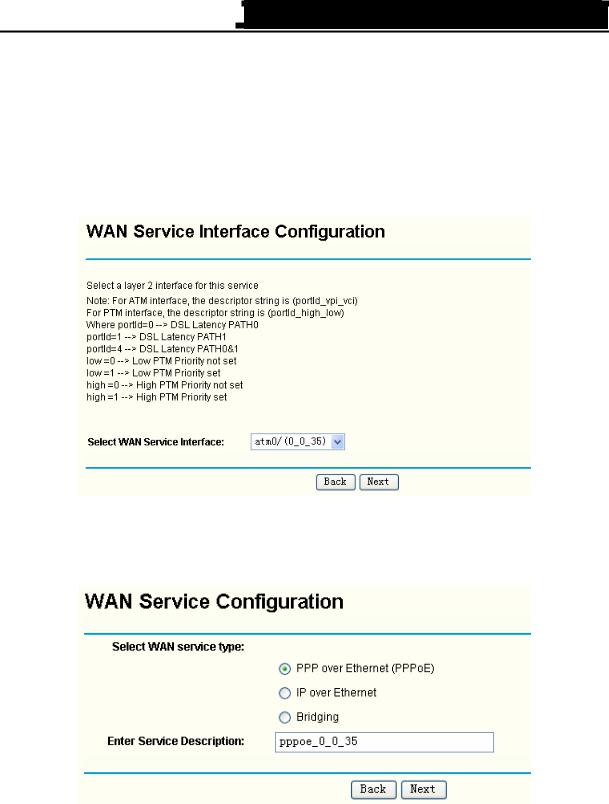
TD-W8960N  Wireless N ADSL2+ Modem Router User Guide
Wireless N ADSL2+ Modem Router User Guide
4.4.2.1 ATM-EoA-PPPoE
If your ISP provides a PPPoE connection and you need to use an ATM Interface, follow the steps below to add a WAN service over a selected ATM interface:
1.Add a new ATM interface and select EoA option for DSL Link Type (4.4.1.1 ATM interfaces).
2.Click the Add button on the screen Figure 4-8 and select WAN Service Interface over ATM PVC on the next screen.
Figure 4-9
3.Select the WAN Service type on the screen as follows. You can enter the service Description to be service name in the text box or leave the default name.
Figure 4-10
4.If your ISP provides a PPPoE connection, select PPPoE option. And you should enter the following parameters.
20
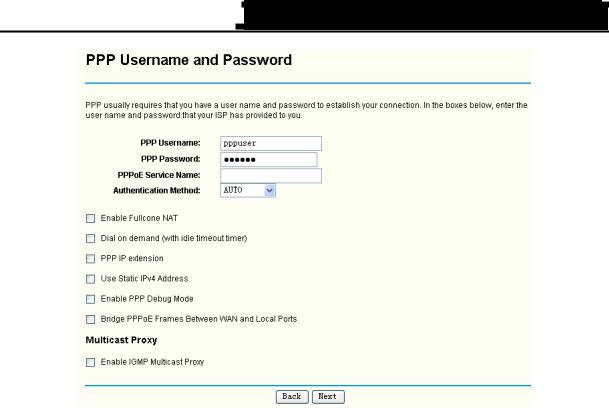
TD-W8960N  Wireless N ADSL2+ Modem Router User Guide
Wireless N ADSL2+ Modem Router User Guide
Figure 4-11
¾PPP Username/Password: Enter the User Name and Password provided by your ISP. These fields are case-sensitive.
¾PPPoE Service Name: Enter the Service Name if it was provided by your ISP. If you leave it blank, the default name will be the same as the service Description on the previous screen.
¾Authentication Method: Select the Authentication Method in the drop-down list, the default method is AUTO, and you can leave it as a default setting.
) Note:
If you are not sure about the PPP IP extension and PPP Debug Mode etc. below, please don’t select these options.
¾Enable Fullcone NAT: It is a type of NAT, if not enabled, the default NAT will act.
¾Dial on demand (with idle timeout timer): The Router will cut off the Internet connection after it has been inactive for a specific period of time (idle timeout), and it will automatically re-establish the connection as soon as you attempt to access the Internet again. If your Internet is charged by time you may want to select this option in order to save money.
¾PPP IP extension: Select this option to get the public IP address from the PPP server to your PC, and the NAT and SPI Firewall will be closed. Sometimes you can think it as bridge while PPP dialing in the router. It’s a special feature deployed by some ISP. Unless your ISP specifically requires this setup, do not select it.
¾Use Static IPv4 Address: If your ISP gives you a static WAN, Gateway and DNS IP address, select this option to enter them manually.
¾Enable PPP Debug Mode: Select this option to debug the PPP function and you can see many PPP log information in the System Log. Only PPP has this debug Mode.
¾Bridge PPPoE Frames Between WAN and Local Ports: Select this option to start PPP connection in your local PC.
21
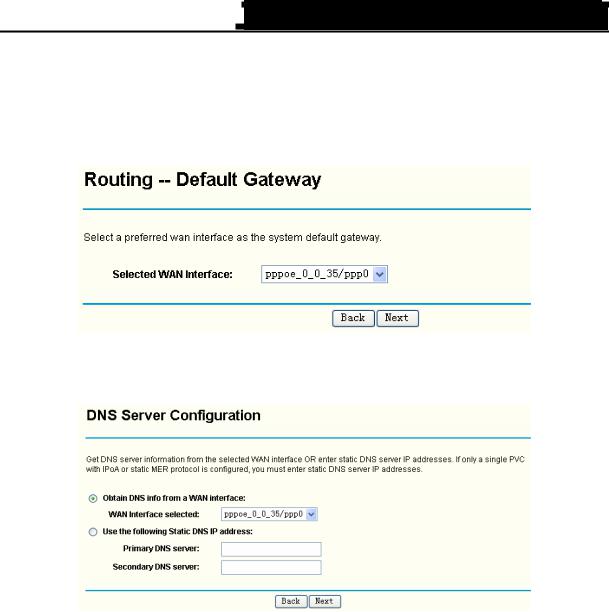
TD-W8960N  Wireless N ADSL2+ Modem Router User Guide
Wireless N ADSL2+ Modem Router User Guide
¾Enable IGMP Multicast Proxy: IGMP (Internet Group Management Protocol) is used to manage multicasting on TCP/IP networks. Some ISPs use IGMP to perform remote configuration for client devices, such as the Router. The default value is disabled, and if you are not sure, please contact your ISP or just leave it.
5.Select a preferred wan interface as the system default gateway.
Figure 4-12
6.Configure the DNS Server Addresses on the screen as follows.
Figure 4-13
¾Obtain DNS info from a WAN Interface: You can select this option to automatically get DNS server information from the selected WAN interface.
¾Use the following Static DNS IP Address: You can select this option to manually enter the primary and /or optional secondary DNS server IP addresses provided by your ISP.
) Note:
If only single PVC with IPoA is configured, you must enter static DNS server IP addresses.
7.On the next screen you will see the detailed settings you’ve made. Please click the Apply/Save button to save these settings.
22
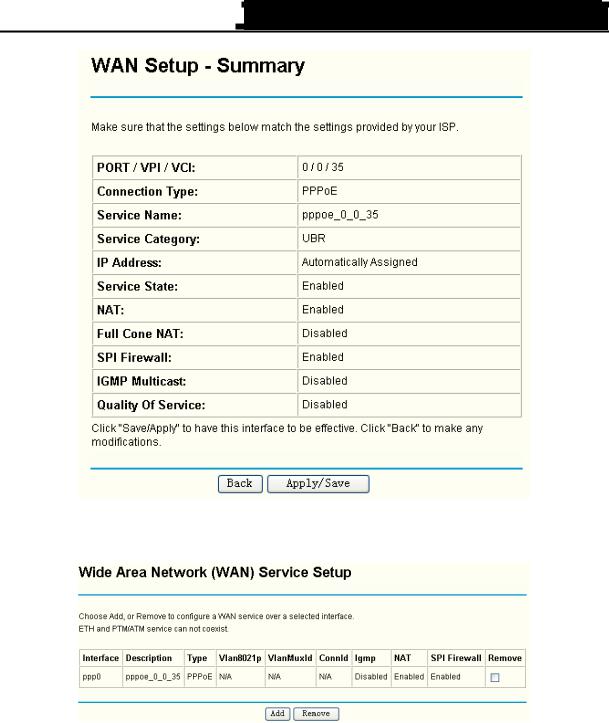
TD-W8960N  Wireless N ADSL2+ Modem Router User Guide
Wireless N ADSL2+ Modem Router User Guide
Figure 4-14
8.On the next screen you will see the WAN Port Information Table with the new configuration.
Figure 4-15
¾Remove: Select the check box in the table above and then click Remove, the corresponding interface will be deleted in the table.
¾Add: Click the Add button, and you can add a new interface in the next screen.
4.4.2.2ATM-EoA-IPoE
If your ISP provides an IPoE connection and you need to use an ATM Interface, follow the steps below to add a WAN service over a selected ATM interface:
1.Add a new ATM interface and select EoA option for DSL Link Type (4.4.1.1 ATM interfaces).
23
